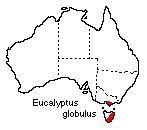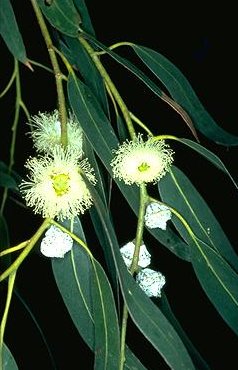| They are arranged alternately on
rounded stems and range from 15 to 35 cm in length. The buds are top-shaped,
ribbed and warty and have a flattened operculum bearing a central knob.
The cream flowers are borne singly in the leaf axils and produce copious
nectar which tends to yield a strongly flavoured honey. The woody fruits
range from 1.5 to 2.5 cm in diameter. Numerous small seeds are shed through
valves which open on the top of the fruit.
 Eucalyptus
globulus subsp. globulus occurs in tall open forest in south-eastern
Tasmania and to a lesser extent along the eastern coast of the State. It
also occurs on King and Flinders Islands in Bass Strait. Outside Tasmania
it is confined to Wilson's Promontory and the Cape Otway district in southern
Victoria. The climate throughout its range is cool to mild, with wet winters
and reliable summer rainfall. Within parts of its range, light frosts and
snowfalls occur. Eucalyptus
globulus subsp. globulus occurs in tall open forest in south-eastern
Tasmania and to a lesser extent along the eastern coast of the State. It
also occurs on King and Flinders Islands in Bass Strait. Outside Tasmania
it is confined to Wilson's Promontory and the Cape Otway district in southern
Victoria. The climate throughout its range is cool to mild, with wet winters
and reliable summer rainfall. Within parts of its range, light frosts and
snowfalls occur.
Tasmanian Blue Gum is protected in
conservation areas such as Maria Island National Park, Freycinet National
Park, Tasman Arch Nature Reserve and St Mary's Pass Nature Reserve. Outside
State reserves it occurs in reserves managed by the Department of Lands
and the Forestry Commission. Both authorities have regulations prohibiting
the taking of native flora from Crown Land and State forests respectively
without prior permission of the managing authority.
Being a
very tall evergreen tree Tasmanian Blue Gum is unsuitable for cultivation
in the average home garden but it can be recommended as a handsome subject
for parks and large gardens in regions which do not experience severe frosts.
It is easily propagated from seeds. In subtropical horticulture it has
enjoyed popularity as a bedding plant, with freshly raised seedlings being
planted each year. Its horticultural value lies in the unusual effect achieved
by the colour and form of the juvenile foliage. It is grown successfully
in large gardens in Cornwall, where the cool to mild, damp climate is favourable.
The flowers are usually inaccessible
and so they are seldom available for indoor decoration. The large blue-grey
juvenile leaves are ideal as backing material in floral arrangements in
which an unusual colour effect and bold form are desired. Either fresh
or dried foliage may be used. Both emit the distinctive eucalyptus fragrance
so evocative of the Australian bush.
Tasmanian Blue Gum yields pale, hard
and durable timber which is used in Australia for poles, piles and sleepers.
The species has been widely planted in New Zealand, South Africa, South
America, California, India and Mediterranean countries, in farm windbreak,
forestry and ornamental plantations. Among the qualities
admired overseas are its rapidity of growth, straightness of trunk, strength
of wood and adaptability to a range of sites. Originally overseas plantations
supplied antiseptic oil, fuel, telegraph poles, mine props and construction
timber. In addition they now provide pulpwood for paper and rayon manufacture.
It has also contributed to the drainage of swamps in malarial localities
in central Africa, Italy and Turkey. Before the role of the malarial mosquito
in spreading the disease was understood, there was a superstitious belief
that the leaves of the Blue Gum released a magical essence which purified
the air of fever germs. In reality the benefit is derived from the
loss of suitable breeding sites for mosquitoes, brought about by the capacity
of the trees to evaporate water from the swampy ground.
Tasmanian Blue
Gum is so abundant in coastal areas of California that many people assume
it is a native species. In recent years concern has been expressed that
it appears to be becoming naturalised. Studies show that there is a tendency
for it to spread from plantations by seed dispersal along drainage lines
but it is doubtful that it will ever become troublesome. |

 Eucalyptus
globulus subsp. globulus occurs in tall open forest in south-eastern
Tasmania and to a lesser extent along the eastern coast of the State. It
also occurs on King and Flinders Islands in Bass Strait. Outside Tasmania
it is confined to Wilson's Promontory and the Cape Otway district in southern
Victoria. The climate throughout its range is cool to mild, with wet winters
and reliable summer rainfall. Within parts of its range, light frosts and
snowfalls occur.
Eucalyptus
globulus subsp. globulus occurs in tall open forest in south-eastern
Tasmania and to a lesser extent along the eastern coast of the State. It
also occurs on King and Flinders Islands in Bass Strait. Outside Tasmania
it is confined to Wilson's Promontory and the Cape Otway district in southern
Victoria. The climate throughout its range is cool to mild, with wet winters
and reliable summer rainfall. Within parts of its range, light frosts and
snowfalls occur.